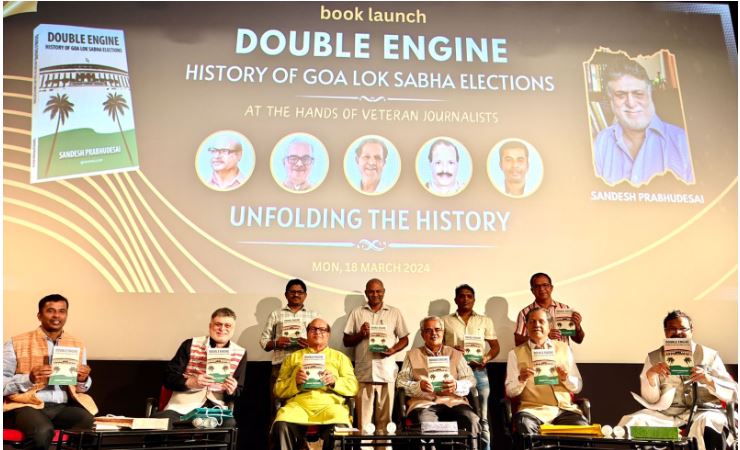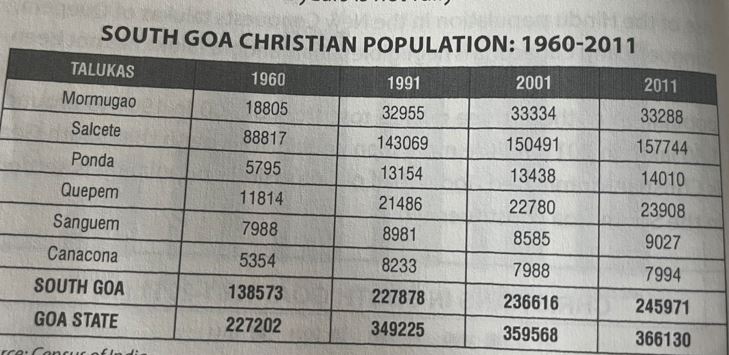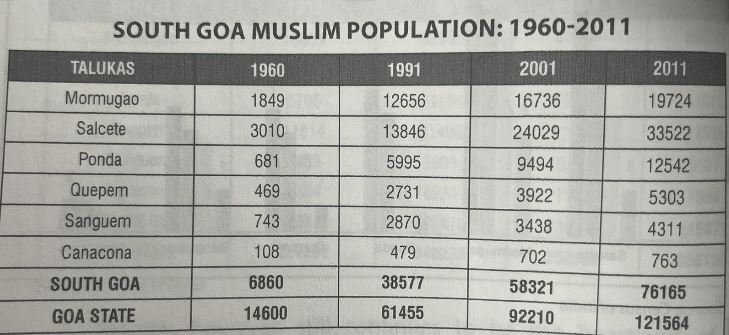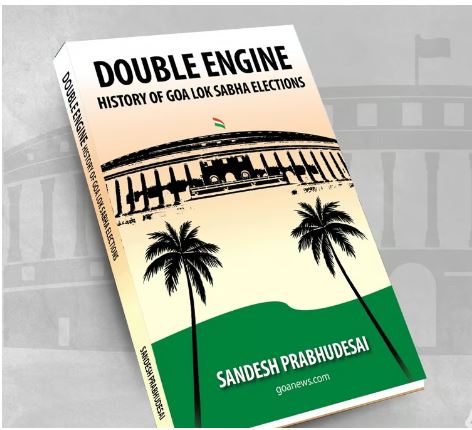`Double Engine, History of Goa Lok Sabha Elections’ by Sandesh Prabhudesai, published by goanews.com, softcover, Rs300.
By Tara Narayan
TO understand Goa you have to understand its politics since Liberation, Opinion Poll and Statehood, its Portuguese time colonial history of over 400 years. Goa has inspired many books but this one by media veteran Sandesh Prabhudesai titled “Double Engine, History of Goa Lok Sabha Elections” is a special for our times to screen all-important data. It is contemporary and makes for more immediate encapsulated reading in its studied account of how Goa is changing rapidly with the BJP’s so called “double-engine” mode of accelerating development in the last 14 years.
This, regardless of whether the people of Goa like or don’t like urban, industrial modes of development and progress which in the short and long run impact vital air, earth and water resources. Being a small and educated state with the highest per capital income, most Goans want to retain their still green, water rich paradise, and revive dying agriculture (as a younger generation takes to urban mod con and white-collar lifestyles with accompanying damages to environment and health profiles)…

The Centre with Prime Minister Narendra Modi takes a keen interest in the state of Goa and a multitude of programs are changing a much loved traditional cultural ambience, Goa’s religious demographics are changing and soon its image of the much loved perfect East-West cosmopolitanism may be gone with the wind, to be replaced by Shri Ram alone knows what!
We must take a keen interest in the politics driving our present and future in the larger interests of survival and peace on earth. In Sandesh Prabhudesai’s “Double Engine, History of Goa Lok Sabha Elections” you will find very many interesting refresher courses of Goa’s politics as it has transformed over the years and how it may hope to revive and change for larger causes, than the smaller causes which worry so many Goans today.
Sandesh Prabhudesai says that Goa has always been beholden to the Central government and this is not a recent phenomena, the double engine formula is basically a dependent mindset! Perhaps whatever independence of mind and spirit Goans had will return sooner or later as it rides out the waves of “ghar wapasi” Hindutva if not integral, secular Hinduism as an older generation’s sensitivity and sensibility will testify.
You may want to read this book as a quickie if Goa’s history fascinates you and since the parliamentary elections are around the corner. It is full of painstakingly collected and compiled data with maximum straightforward analysis and minimum opinion. It’s a most useful book for students of politics.
Excerpted from `Double Engine, History of Goa Lok sabha Elections’ by Sandesh Prabhudesai…
The Changing Face of South Goa
THE South Goa Lok Sabha constituency, especially with the Salcete and Mormugao talukas of the Old Conquest holding 12 Assembly segments out of 20, always remained Christian-dominated. Despite the fact that Hindus were the majority in the south district as well. Except for the commercial city of Margao and the port town of Mormugao. Christians were either a majority or a strong united vote bank in the remaining 10 Assembly segments of both the talukas.



The game-changing impact of this was strongly felt at the historic Opinion Poll. The tables were turned when the counting of Salcete and Mormugao began. Unlike the Hindu community, the Christian community was not at all divided on the merger issue While the Goan identity was retained with an overall margin of 34,000 votes, these two talukas had provided a huge margin of around 50,000 votes. It was a 78% v/s 22% battle in the Old Conquests of South Goa. And in spite of having Hindu-dominated talukas like Ponda, Sanguem, and Canacona, the whole of South Goad had a lead of over 38,000 votes opposing the merger. In Quepem taluka, both Assembly segments of Curchorem and Quepem had tilted in favor of Two Leaves (symbol of anti-merger).
It is precisely due to this reason that despite ruling the state for around 16 years, the MGP could never win the Lok Sabha election of South Goa, except for the first tightrope battle of 1963. Out of 16 polls held to date, including one by-poll, the party predominantly of the Hindu Bahujan Samaj contested only eight polls. Only four among these had Hindu candidates. Four more times, the party fielded reputed Christian candidates like Prof Dionisio Ribeiro and Adv Joachim Dias while twice supporting independent candidates. One among them was Christian. Six times the party simply did not contest the Lok Sabha polls.
During the tenure of Bhausaheb Bandodkar and Shashikala Kakodkar and even when Ramakant Khalap and Dr Kashinath Jalmi were the opposition leaders, the MGP was not a Hindutva party. It was tilting more towards the socialist ideology. Bhau Bandodkar believed in the Radical Humanism of MN Rao, a Marxist with a difference. Dr Jalmi rose up through the Rashtra Seva Dal, an organization that believed in Gandhian Socialism. But the BJP is a rightwing political party of the Rashtriya Swayamsevak Sangh (RSS). MS alias Guru Golwalker’as book Bunch of Thoughts’ is considered to be the Bible of the Sangh Parivar. He has written three different chapters oninternal threats,’ titled the The Muslims,’The Christians,’ and `The Communists.’
This hardcore Hindutva party has won the South Goa seat twice : Ramakant Angle in 1999 and Narendra Sawaikar in 2014. In 2019, Sawaikar lost the battle against Congress MP Francisco Sardinha by just 9,800 votes when over 4.24 lakh electorate had exercised their franchise. The South Goa constituency has always been a model for Goa, when Hindu-Christian-Muslims would elect their MP together, in tune with the state’s communal harmony. This trend seems to be changing at a very fast pace.
THERE was a time when, except for Margao, the rest of the seven Assembly segments were Christian-dominated. But now, the Salcete taluka is divided into two clusters of four segments each. One is becoming Hindu dominated, while the other is a bastion of Christian voters. The Christian cluster includes Nuvem, Benaulim, Curtorim, and Velim. It still holds over 70 per cent of the Christian vote. But then it had around 80 per cent of voters two a years ago, in the 2017 Assembly poll.
The second cluster includes Margao, Fatorda, Navelim, and Cuncolim. In the 2017 Assembly poll, the Hindu voter was 45 per cent, as compared to 40% of Christian. Only a five per cent difference. But within two years, the gap had widened tremendously. The Hindu voter is around 50 per cent, while the Christian voting has slumped down to a mere 35 per cent. A huge gap of 15 per cent! Regarding actual numbers Hindu voters are nearly 60,000 while Christian voters are around 42,000. A gap of around 18,000! In addition, the Muslim tally goes up to 18,000!
